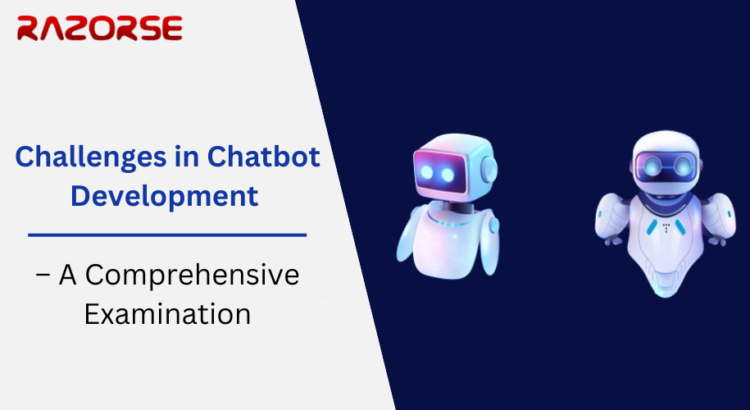As the digital landscape continues to advance at a rapid pace, chatbots have emerged as a key tool for enhancing customer interactions, automating services, and streamlining business processes. From simple customer support bots to advanced AI-driven assistants, chatbots are being integrated into websites, apps, and social media platforms across industries. However, developing a chatbot that is effective, reliable, and capable of meeting user expectations is no simple task. There are several challenges that developers face throughout the process. Following are the key challenges in chatbot development and explore strategies to overcome them.
1. Understanding User Intent
One of the primary challenges in chatbot development is accurately understanding user intent. Human language is complex, and users may express the same intent in numerous ways, use slang, or even make typos. Natural Language Processing (NLP) models have come a long way, but they still struggle with interpreting nuances, context, and indirect language.
Solution:
To tackle this, developers need to train their chatbots on diverse datasets that encompass a wide range of language expressions. Incorporating machine learning techniques can help the chatbot learn and adapt to new phrases over time. Additionally, using a combination of rule-based and AI-driven approaches can enhance the chatbot’s ability to comprehend and respond to user inputs more accurately.
ALSO READ:- The Future of Chatbots: Comprehensive Guide to Use Cases & Opportunities
2. Handling Complex Conversations
While simple, linear conversations are easy for chatbots to manage, real-world interactions are often far more complex. Users might switch topics mid-conversation, ask multiple questions at once, or provide incomplete information. This complexity can lead to confusion, incorrect responses, or frustration on the part of the user.
Solution:
Implementing a robust conversation management system is crucial. This involves designing the chatbot to maintain context, track user preferences, and handle interruptions smoothly. Developers can also integrate fallback mechanisms that redirect the conversation to a human agent or provide users with options to clarify their requests.
3. Ensuring Data Security and Privacy
As chatbots handle sensitive user data, including personal information and financial details, ensuring robust data security and privacy is a significant challenge. Any vulnerability in the chatbot system could lead to data breaches, compromising user trust and exposing businesses to legal liabilities.
Solution:
Developers must adhere to strict security protocols, such as encryption, secure API calls, and regular security audits. It’s also essential to comply with data protection regulations, like GDPR, and to provide users with clear information on how their data is being used. Implementing features like user consent and data anonymization can further enhance security.
4. Providing a Human-Like Experience
Users often expect chatbots to provide a human-like conversational experience. However, creating a chatbot that can replicate the subtleties of human communication, such as understanding emotions, humour, and cultural references, is a formidable challenge.
Solution:
To create a more natural interaction, developers can incorporate sentiment analysis to gauge user emotions and tailor responses accordingly. Additionally, including features like conversational memory, where the chatbot remembers past interactions, can make the experience feel more personalized and human-like. Regular updates and improvements based on user feedback are also critical to refining the chatbot’s performance.
6. Integrating with Existing Systems
Chatbots need to integrate seamlessly with existing business systems, such as customer relationship management (CRM) tools, payment gateways, and inventory management systems. Achieving this integration can be challenging, especially when dealing with legacy systems that may not be designed to work with modern chatbot platforms.
Solution:
Developers can use middleware and APIs to bridge the gap between the chatbot and existing systems. It’s also important to choose chatbot development platforms that offer flexibility and compatibility with a wide range of business applications. Testing the integration thoroughly before deployment is essential to avoid disruptions.
7. Managing User Expectations
Users may have unrealistic expectations of what a chatbot can do, expecting it to function like a human or solve complex problems instantly. When these expectations are not met, it can lead to dissatisfaction and a negative perception of the chatbot.
Solution:
Setting clear user expectations from the outset is key. This can be done through onboarding messages that explain the chatbot’s capabilities and limitations. Providing users with a straightforward way to escalate to a human agent when necessary can also help manage expectations and improve the overall user experience.
Conclusion
Developing a successful chatbot involves navigating a range of challenges, from understanding user intent to ensuring data security and providing a human-like experience. By adopting a strategic approach and leveraging the latest technologies, developers can overcome these challenges and create chatbots that not only meet but exceed user expectations. As chatbots continue to evolve, they will play an increasingly important role in enhancing customer experiences and driving business growth. At Razorse Software, we are committed to helping businesses harness the power of chatbots by providing expert development and integration services tailored to your unique needs.
